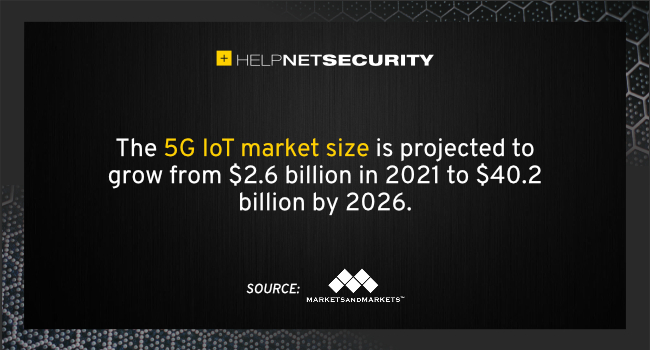5G IoT market size to reach $40.2 billion by 2026
The 5G IoT market size is projected to grow from $2.6 billion in 2021 to $40.2 billion by 2026, at a Compound Annual Growth Rate (CAGR) of 73.0% during the forecast period, according to MarketsandMarkets.

5G networks support high bandwidth, low latency, and massive device volumes with high mobility and low bandwidth, and low-power device estates across a wide range of technologies, including 4G/5G, satellite and Wi-Fi, and low-mid-high spectrum bands.
The 5G networks deliver the performance needed for production monitoring and condition-based maintenance, quality management using vision analytics, advanced robotics, and human worker coordination across all verticals. There are immense new opportunities in this market.
The increasing number of IoT-connected devices and agile networks, network slicing, and private 5G networks among the emerging technologies is expected to shape the future of the 5G IoT market.
Connectivity segment to grow at the highest CAGR
5G is the next-generation connectivity technology that would enable a wide range of IoT devices to communicate in short- and long-range distances. It promises higher speed, wider coverage, greater security, and lower latency. It significantly improves the power consumption of IoT devices and supports connectivity for millions of connected devices.
5G has a wide range of use cases across manufacturing, energy and utilities, healthcare, government, automotive, retail, and agriculture. NB-IoT and LTE-M have already started gaining traction, building a strong framework for cellular IoT to support a broad range of IoT use cases such as telemedicine, smart meters, connected cars, fleet management, and smart cities.
Healthcare is expected to grow at the highest CAGR
5G opportunities in healthcare rely on a combination of massive IoT and enhanced broadband to support telemedicine. 5G IoT improves diagnoses requiring multiple connections at a remote site (patient dialysis at home or remote control of medical equipment). Telemedicine and connected equipment inside hospitals would be possible using 5G.
Massive IoT strides were witnessed in 2020. For Instance, Saratoga Hospital in Saratoga Springs, New York, US, was bogged down with administrative tasks such as taking patients vital signs every few hours and manually logging results. To improve clinical outcomes and enhance patient safety, the organization turned to Philips for the IoT-enabled patient monitoring technology.
APAC region to record the highest market share in the 5G IoT market in 2020
APAC is the fastest-growing region in the 5G IoT Market; this growth can be attributed to the significant adoption of advanced technologies, the proliferation of IoT-enabled devices, continuously enhancing network connectivity and government initiatives for IoT.
APAC is one of the biggest markets for connected devices. APAC is a diversified region that houses a wide range of countries moving toward digital transformation. The region is set to dominate 5G, edge computing, blockchain, and 5G core technology, due to its size, diversity, and the strategic lead taken by countries, including Singapore, South Korea, China, Australia, and Japan.
Key and innovative vendors in the 5G IoT market include China Mobile (China), AT&T (US), Verizon (US), T-Mobile (US), Vodafone (UK), Orange S.A (France), Telefonica (Spain), SK Telecom (South Korea), Deutsche Telekom (Germany), Ericsson (Sweden), Huawei (China), Nokia (Finland), Samsung (South Korea), Cisco (US), NEC (Japan), Sierra Wireless (Canada), Thales (France), Telit (UK), Quectel (China), SIMCom (China), GosuncnWelink (China), Neoway (China), Fibocom (China), u-blox (Switzerland), and Sequans (France).